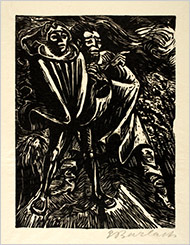Ernst Barlach was a German expressionist who participated in WWI and through being involved became an avid protester. He is most well known for his sculptures protesting the war and much of his artwork was banned by the Nazi party.
For example, here is a picture of one of his sculptures that contributed to the large controversy over his artwork.
However, in addition to sculpture, Barlach also did many woodcuts and charcoal drawings. Through these drawings he helped initiate the German expressionist movement.
This is an example of one of Barlach's expressionist woodcuts, "Faust and Mephistophele II" (1923).
The main point of expressionist artwork is to convey an emotion. Through his sharp lines and swirls, combined with the stark contrast of dark and light that is created in the wood cut, Barlach definitely conveys a sense of grief and toil.
Many art critics have described Barlach's work as having a sense of inward reflection. It seems like the characters, even if in a scene with others, are often isolated in their own thoughts and brought to life that way. Barlach often focused on depicting the downtrodden or the poor.
In this sculpture called "One-Legged Man," you can really sense the man shielding his body from the cold and stumbling along.
Many of Barlach's prints and illustrations were made for books.
This is a charcoal drawing he did for the German epic "The Nibelungenlied." Despite the sketchy quality of the drawing, the sense of expressionism is still very evident.
Before his work protesting the war, he was inspired by a trip to Russia and drew many pictures depicting peasants. The angular poses of the figures and sweeping and emotive lines already convey an expressionist style even in his early works.
I chose to write about Barlach because I had actually never heard of him before. I wanted to do research on an artist who I had never encountered before, but I also wanted the artist to use charcoal as a medium. Charcoal is a very expressive medium because you really have to be confident to put those dark lines down on the paper. I think it was a perfect medium for Barlach who often conveyed a dark and sad emotion. From his depiction of downtrodden peasants to World War I victims, Barlach's subjects were most often depressed figures. Sadness is one of the strongest emotions to depict and I think Barlach really succeeded in all the mediums that he used.
http://www.nytimes.com/2009/05/17/nyregion/new-jersey/17artsnj.html?_r=0
http://www.moma.org/collection_ge/browse_results.php?criteria=O:AD:E:335|A:AR:E:1&role=1
Subscribe to:
Post Comments (Atom)





No comments:
Post a Comment